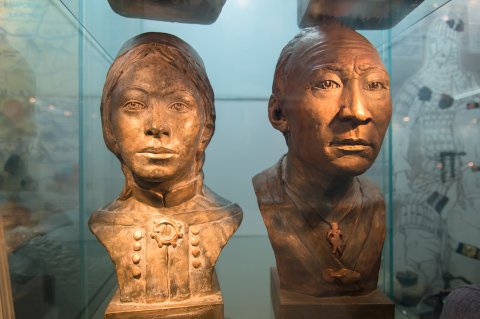The Research Laboratory for Migration Studies, created at South Ural State University within the fulfilment of Program 5-100, aims at developing the scientific-and-research cluster for studying migrations by using innovative cross-disciplinary methods. The laboratory is headed by Professor of Carleton University, Canada, Jeff Sahadeo. On behalf of SUSU, it is supervised by Doctor of Sciences (History), Professor Olga Nikonova, who shared on the work being carried out by this international laboratory.
– Professor, could you please explain why migration studies are relevant today?
O.N.: Migration is one of the fundamental features of human community. Scientific studies confirm that the moving around of human groups was typical both for the most ancient epochs and for later stages of human history. Today, the migration crises, which are different in character and intensity, make the topic of migration studies relevant, as the society is in need of a detailed, and if possible, complete reconstruction of the migrations history in order to come up with proper solutions to modern problems. To solve these problems, which are relevant for the whole world, the International Laboratory for Migration Studies was created at SUSU.

Photo: Head of the Laboratory for Migration Studies Olga Nikonova, and Andrey Epimakhov
– In which fields is research being conducted at the laboratory?
O.N.: The research in the Laboratory for Migration Studies is being conducted in several main fields. We’re dealing with the reconstruction of the practices of migration flows regulation; methods and techniques of managing big masses of migrating people; studying of the technologies of ensuring safety and humane methods of transportation, so that we could elaborate proper solutions for modern problems. It is also very important to analyse and summarize the historical experience in solving the migration problems in the past, to study the migration processes based on the archaeological and historical materials. The research being carried out aims at revealing the universal patterns and unique phenomena, diagnostics of the forms and stimuli of migrations, their role in the forming of cultural stereotypes and social structures, and all of that through using the results of multidisciplinary studies.
– Who is part of the research team?
O.N.: The laboratory’s research team comprises specialists representing South Ural State University; Russian State University for the Humanities; Carleton University, Canada; Carl von Ossietzky University of Oldenburg, Germany; Smithsonian National Museum’s Arctic Studies Centre, USA. For us to be able to solve the laboratory’s research tasks, we have established international collaboration with Carleton University; Goethe University; Carl von Ossietzky University of Oldenburg; University of Munich, Germany; University of Michigan; Harvard Medical School; and University of Pittsburgh, USA, as well as with University of Gothenburg, Sweden.
– What results have you managed to achieve?
O.N.: The results of work in the field of migration studies were published in authoritative journals indexed in Scopus database (American Journal of Physical Anthropology; Nature; Kritika, etc.). In the period of 2016 – first half of 2019, we took part in 13 international conferences in countries of Europe and Asia, and held 5 communication events (public lectures, seminars). Thus, in February of 2019, the first meeting of the Seminar on Eurasia in the Context of Migratory Processes in the 17th-20th Centuries was held. Moreover, we have won several grants on the migrations issues: “Russian Revolution, Migration and Hygiene: Prospects and Problems of the Soviet Cultural History of Odours” (in partnership with the Swiss National Foundation); “Borderzone of Cultural Worlds (South Ural Region from the Ancient Times to the Modern Period)” (grant from the Russian Federation Ministry of Education and Science); and “Chelyabinsk Migratory Settlement in the Colonial Discourse of the Russian Migration” (German Historical Institute Moscow). And we keep working in this field.
.jpg)
– Do SUSU students participate on the work of the laboratory?
O.N.: The integration of science and education is ensured thanks to an inter-faculty educational project on Interactive Electronic Application on the Historical Reconstruction of the City of Chelyabinsk. The main idea is to present Chelyabinsk as a crossroads of the migration flows. Nine students and postgraduates are involved in the laboratory’s work. We are fulfilling an academic mobility program with universities in Germany (Heidelberg University, Humboldt University of Berlin), USA (Florida International University), and Switzerland (University of Basel).
– What kind of research is planned to be conducted by the laboratory in the future?
O.N.: Studies in the following fields open big prospects for us: archaeology of the transition zones in Eurasia; problems of social and cultural changes in Eurasia in the Late Middle Ages and Modern Era; migration processes in modern era; and current migration processes. To expand our international collaborations, we are planning on signing partnership agreements with Institute for Migration Research and Intercultural Studies, Osnabrück, Germany; and Northwestern Polytechnical University, Xi'an, China; and organizing the SUSU’s entering the Alliance for Preserving the Cultural Heritage of the Great Silk Road and Science-and-technology Innovations. In 2019-2020 we are planning the publications in journals indexed in Scopus/ Web of Science databases. Some of the articles have already been written and undergone first peer-reviewing; and we have performed a serious scientific groundwork for our further publication activity.




